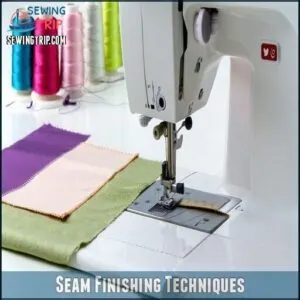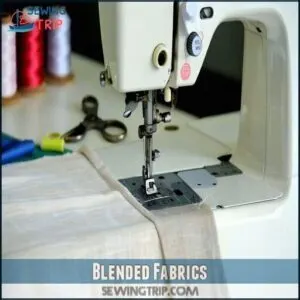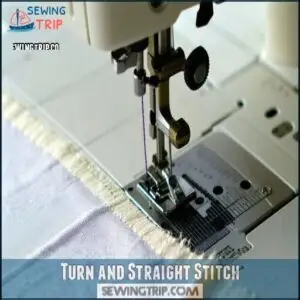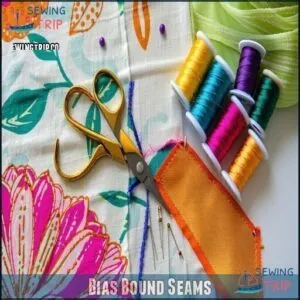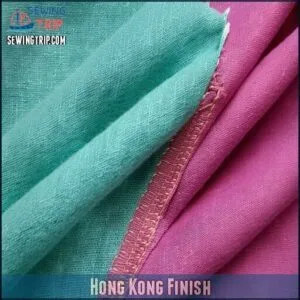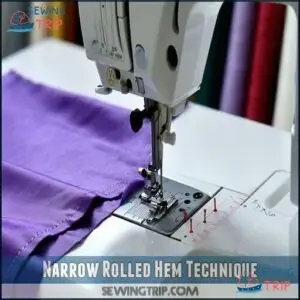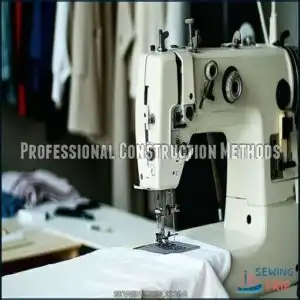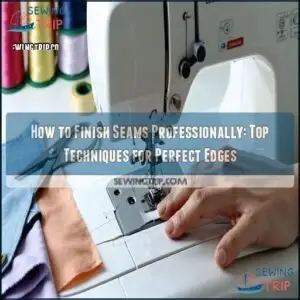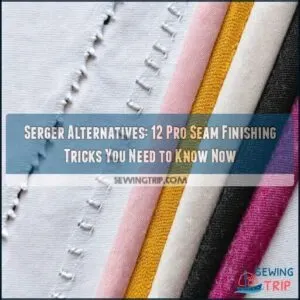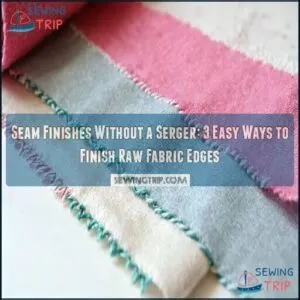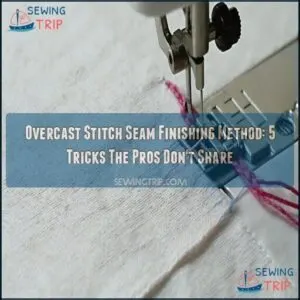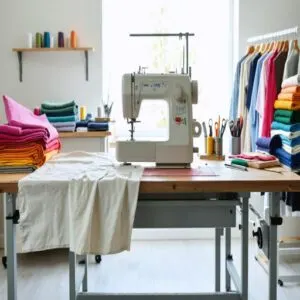This site is supported by our readers. We may earn a commission, at no cost to you, if you purchase through links.

Try French seams for delicate fabrics or mock French seams when speed matters.
Flat-felled seams give a durable, polished look, while clean finish seams or zig-zag stitching prevent fraying on casual projects.
Picking the right technique depends on your fabric and garment type—think of it like pairing the perfect wine with dinner.
For a truly professional touch, consider bias-bound seams or a Hong Kong finish on unlined pieces.
Each method has its charm and purpose, so experiment to find the best fit for your project’s personality.
Table Of Contents
Key Takeaways
- Use French seams for lightweight fabrics and mock French seams when you need a faster, neat finish.
- Flat-felled seams add strength and a polished look, perfect for denim and workwear.
- Bias-bound seams and Hong Kong finishes elevate unlined garments with clean, decorative edges.
- Match seam techniques to your fabric type, press seams carefully, and use the right tools for a professional result.
Seam Finishing Techniques
You’ll transform your homemade clothes into professional-looking garments by mastering these essential seam finishing techniques.
With the right method for each fabric type, you can say goodbye to frayed edges and hello to polished, durable seams that look store-bought.
French Seams
French seams are your secret weapon for creating professional-looking garments, especially with lightweight fabrics and sheer materials.
French seams elevate lightweight fabrics with enclosed edges, delivering lasting durability and a flawless, professional finish.
You’ll sew twice—first with wrong sides together, then right sides—creating a durable finish with completely enclosed edges.
This technique requires precise seam allowance measurements (typically ¼" + ⅜" for a standard ⅝" allowance), but delivers a beautifully clean finish worth the extra effort.
For a quicker alternative, consider the mock french seam which is easier to sew.
Mock French Seams
Mock French seams are quick, neat, and ideal for lightweight fabrics.
Start by sewing the seam right sides together. Then, press raw edges toward the seam line and stitch them closed.
This technique offers durability, a cleaner interior, and no stress about initial fabric choice or seam math.
Perfect for sharp finishes without specialized tools—just focus on stitch length and pressing technique.
This is especially useful for fabrics where you want to avoid fraying edges.
Clean Finish Seams
Clean finish seams are a go-to for sleek, polished results. They’re easy, versatile, and reduce bulk.
Effortless and versatile, clean finish seams transform raw edges into sleek, polished perfection for truly professional garment results.
Here’s how to master them:
- Fold raw edges under the seam allowance carefully.
- Use pressing techniques to guarantee the folds stay crisp.
- Stitch each side separately for a clean look.
Achieving professional results often requires the right tools for perfecting these seams.
- Ideal for zipper insertion or inseam pockets, they’re perfect for professional sewing at home!
Flat Felled Seams
Flat felled seams, a durability-focused technique, are ideal for denim application and shirt construction.
They create strong, flat, enclosed finishes with visible topstitching options, often used in industrial sewing.
Trim one seam allowance, fold, and stitch down.
Use this for extra strength and a polished look.
| Feature | Benefit | Example Use |
|---|---|---|
| Enclosed raw edges | Prevents fraying | Jeans, jackets |
| Durable seam finish | Withstands heavy wear | Denim, work shirts |
| Professional look | Neat topstitching options | Casual, formal shirts |
Zig-Zag Seams
A zigzag stitch seam is one of the simplest and quickest seam finishing techniques.
Adjust your stitch width and density to match your fabric stability. For fray-prone materials, tighter zigzag stitching works best.
Decorative zigzag stitches can also enhance designs. Tension adjustments improve results, so test on a scrap first.
Zigzag stitching is effective, versatile, and a breeze with most sewing machine stitches.
Choosing Fabric Wisely
The fabric you choose directly impacts how your seams look and hold up over time.
Prioritize materials that match your sewing project’s needs, like durability, comfort, and ease of care.
Natural Fabrics
Natural fabrics like cotton and linen are perfect for achieving professional seam finishing at home.
They combine durability, comfort factors, and easy handling when applying seam finishing techniques like clean finish seams.
Natural fibers absorb dye beautifully, providing vibrant results with naturally dyed options.
Plus, choosing ethically sourced fabrics elevates your garment’s quality while reflecting thoughtful, sustainable craftsmanship.
Blended Fabrics
Blended fabrics balance natural and synthetic materials for versatility and savings.
They’re known for their blend durability and reduced fabric fraying, making them perfect for a professional finish.
Consider these factors:
- Fiber Ratios: Check the mix for strength and stretch.
- Weave Types: Tighter weaves last longer.
- Cost Savings: Affordable yet polished.
- Blended Comfort: Softness with resilience.
Fabric Texture and Comfort
When choosing fabric, think about its feel against your skin and how it moves.
A fabric with good drape quality hugs curves without stiffness.
Consider the breathability factor—linen keeps you cool; polyester might trap heat.
Seasonal comfort matters, so match fabric to weather needs.
Clean finish seams help eliminate fabric fraying, ensuring long-lasting, irritation-free garments.
Care Requirements
Taking care of your fabrics guarantees durable seam finishes and extends garment life.
Before sewing, always pre-wash to prevent shrinkage—you don’t want surprises later. Test a fabric scrap to check washing instructions.
Follow these tips:
- Pre-wash for sewing durability.
- Match washing instructions to fabric type.
- Avoid harsh detergents.
- Gently press seams after washing for professional finishing.
When planning your project, remember to evaluate fabric yardage needs to avoid shortages and ensure you have enough fabric for a successful project.
Mastering Seam Finishes
You can elevate your sewing projects by learning techniques like the turn and straight stitch, bias bound seams, and the Hong Kong finish.
Each method guarantees your garments look polished, minimizes fraying, and adds durability.
Turn and Straight Stitch
A turn and straight stitch is a reliable method for clean finish seams. It suits various fabrics, ensuring durability and reducing bulk for professional results.
This technique works well on straight or curved seams in home projects. Remember to adjust your sewing machine as needed and focus on precision.
Here’s a quick reference:
| Fabric Type | Compatibility | Bulk Reduction Effect |
|---|---|---|
| Lightweight | Excellent | High |
| Mid-weight | Great | Moderate |
| Heavyweight | Fair | Minimal |
| Stretch | Requires testing | Moderate |
| Curved Seams | Excellent | High |
The table provides a summary of the compatibility and bulk reduction effect for different fabric types, including lightweight, mid-weight, heavyweight, stretch, and curved seams.
Bias Bound Seams
Bias bound seams use bias tape to encase raw edges, creating a polished finish perfect for exposed seams.
It works well on tricky areas like curved seams and allows for creativity with binding color contrast.
Many sewers find pre-made bias tape simplifies the process.
- Choose bias tape binding that suits your fabric.
- Opt for binding width options for flexibility.
- Experiment with decorative binding stitching.
- Master neat, clean sewing finishes.
Hong Kong Finish
For a couture touch, the Hong Kong seam finish offers durability and style.
Using bias tape binding, you encase raw edges for clean, polished results.
Perfect for curve applications, it suits fabric pairings like medium to heavy-weight materials.
This sewing technique’s binding aesthetics shine in unlined garments, adding both longevity and elegance. Mastering this guarantees professional sewing tips elevate your projects.
Narrow Rolled Hem Technique
From enclosing edges to adding polish, the narrow rolled hem technique is great for hemming lightweight fabrics or a curved hem.
Follow these steps:
- Sew ¼” from the edge, press it up, and stitch again.
- Use a rolled hem foot for precision.
- Avoid hem slippage by pinning strategically.
- Test rolled hem variations to match fabric weights perfectly.
Professional Construction Methods
You can achieve a polished, store-bought finish by adopting professional construction methods in your sewing projects.
Focus on using industry-standard seam allowances, an efficient order of operations, and precise preparation for clean and accurate results.
Industry Seam Allowances
Seam allowances vary by type and purpose, offering both flexibility and structure.
Industry techniques recommend 3/8" for efficiency, while 1/4" suits neckline seam allowances.
Using standard widths guarantees accuracy improvement and zipper seam matching.
Smaller seam allowance widths reduce fabric waste without compromising strength.
For woven fabrics, consider pinking shears to prevent fraying.
Adopting these guidelines gives your garment finishing a polished, professional finish, enhancing all seam types effortlessly.
Efficient Construction Order
Start strong with an Assembly Line Sewing approach to boost efficiency.
Keeping garments flat simplifies tasks and avoids unnecessary bulk.
Here’s how:
- Sew and press seams flat before assembly.
- Group similar seam types for Batch Sewing.
- Minimize Interruptions by prepping tools nearby.
- Follow logical garment construction steps for clear flow.
- Always double-check seam allowance before stitching to ensure a smooth process with clear flow.
Prepping Cut Pieces
Before sewing, verify proper fabric preparation by applying interfacing where needed and finishing edges to prevent fraying.
Use marking techniques to highlight seam allowances and details. Press pieces flat for precise alignment, enhancing accuracy in stitching.
Stabilize delicate fabrics or those prone to shifting. These pre-pressing benefits save time, improve control, and make your sewing machine work effortlessly on tricky materials. The process involves careful preparation to ensure that the fabric is ready for sewing, and this includes proper fabric preparation and precise alignment.
Engineered Processes
In sewing, engineered processes streamline tasks with efficiency and precision.
Think sewing automation and process optimization using techniques like pre-cutting fabrics and pressing.
Industry techniques like standardized seam allowances minimize waste while ensuring a professional finish.
Ergonomics matter too—organize your workspace thoughtfully.
Mastering these methods improves quality control and helps you achieve couture seam finishes with ease at home.
Advanced Seam Finishing Techniques
You can elevate your sewing with advanced seam finishing techniques that improve durability and create a professional look.
These methods, like Hong Kong seams or narrow rolled hems, combine precision and functionality for polished, lasting results.
Seam Finish Characteristics
Understanding how seams behave is key to sewing quality.
Here’s what to watch for:
- Durability and Fraying: Some finishes, like zig-zag stitches, prevent fraying but may wear out.
- Bulk Reduction: Choose simpler methods for heavy fabrics.
- Visual Interest: Bias binding adds flair.
- Cleanliness Comparison: French seams hide raw edges entirely.
- Professional Appearance: Seam allowance precision guarantees couture-like results.
Best Use Cases for Seam Finishes
Each seam finish shines in its element.
French seams are perfect for lightweight fabrics, lending clean durability without a serger.
Flat felled seams add strength, ideal for denim or activewear.
For cost-effectiveness and exposed seams, try pinking shears.
Zig-zag or overcasting stitches prevent fraying, while a Hong Kong finish balances durability and aesthetic appeal—perfect for unlined garments.
Specialized Seam Techniques
Mastering seam finishes requires specialized techniques for a flawless result.
For that crisp, polished look:
- Achieve Rolled Hem Mastery using snug, clean folds, perfect for delicate edges.
- Explore Hong Kong Binding for decorative, enclosed seams on the Flynn Jacket Pattern.
- Practice bias binding for ultimate versatility, minimizing frays with subtle precision.
Guides like ITF Information or a french seam tutorial guarantee pro-level finesse.
Frequently Asked Questions (FAQs)
What is the difference between seam finishing and edge finishing?
Imagine a crisp edge on your fabric, clean and smooth.
Seam finishing deals with enclosing raw edges for durability, while edge finishing focuses on preventing fraying.
Think of it as protection versus preservation.
How do you make seams look professional?
Press seams painstakingly, trim excess fabric, and choose finishes—like French or flat-felled seams—that suit your fabric.
Use quality thread, precise stitching, and a clean ironed finish to achieve that polished, professional appearance every time.
How do I prevent fabric puckering in seams?
Imagine this scenario: you’re sewing lightweight cotton, and puckering ruins everything.
Use a sharp needle, loosen the tension, and test stitch on scraps.
Match thread and fabric, and press seams properly to avoid frustration.
What tools help achieve precision in seam finishing?
You’ll need sharp scissors, fine pins, a seam ripper, and a measuring gauge for precision.
A clear ruler and tailor’s chalk guarantee accuracy.
For professional results, invest in pinking shears or a serger for clean edges.
Can seam finishes be repaired if damaged?
When seams fray or unravel, it’s like a snag in your favorite sweater—frustrating but fixable.
Trim loose threads, reinforce with stitches, or use seam tape.
Refinish edges to restore strength and appearance easily.
How to handle delicate fabrics without over-stretching?
Use a fine needle and lightweight thread, and adjust your machine tension slightly lower.
Stabilize the fabric with tissue paper or a tear-away stabilizer.
Always sew gently without pulling to avoid stretching, using techniques that help maintain the fabric’s integrity, and sew gently.
What steps ensure even seam allowance adherence?
Align fabric edges carefully, pin perpendicular to the seam line.
Use your machine’s seam guide, and adjust needle position for precision, sew slowly.
Double-check your stitch line to maintain consistent allowance throughout, ensuring a professional finish with consistent results.
Conclusion
Think of mastering professional seam finishing at home like fine-tuning a vintage radio—crisp, clear results require the right settings.
By understanding techniques like French seams, clean finishes, or the Hong Kong method, you’ll enhance your garments’ durability and style.
Each fabric and project calls for a customized approach, so practice often and match techniques to materials.
With care and precision, your sewing projects can rival store-bought quality, transforming homemade pieces into polished, long-lasting creations that embody professional seam finishing and clean finishes.
- https://www.bernina.com/en-US/Machines-US/Series-Overview/NEW-BERNINA-5-Series/BERNINA-535?utm_source=weallsew&utm_medium=blog&utm_campaign=beginner_guide_to_seam_finishes
- https://nhpatterns.com/b/CsI1l
- https://www.moodfabrics.com/blog/the-sollya-romper-free-sewing-pattern/
- https://www.bloglovin.com/blogs/sew-essential-blog-14567169
- https://www.facebook.com/sewessential

